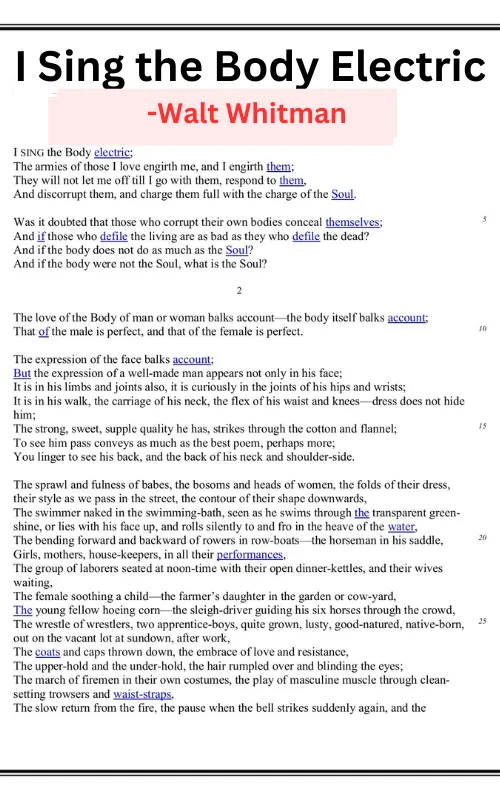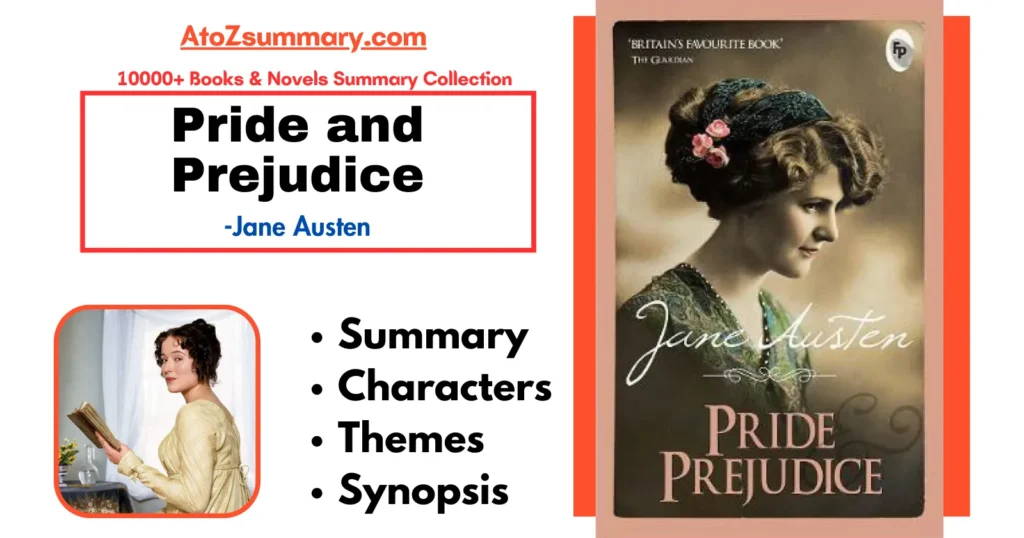About Poem: I Sing the Body Electric
| Title | I Sing the Body Electric |
| Author | Walt Whitman |
| Year published | 1855 |
| Genre | Lyric poem |
| Form | Free verse |
| Literary Movement | Transcendentalism, American Romanticism |
| Structure | The poem is divided into 9 sections, each of which focuses on a different aspect of the human body. |
| Imagery | The poem is full of vivid imagery that celebrates the human body in all its forms. Whitman uses images of the body at work, at play, and at rest to show its strength, beauty, and vitality. |
| Structure | Free verse, 32 lines in the original version |
| Context | Part of Whitman’s “Leaves of Grass,” which is a collection of poems that celebrated individualism, nature, and the American experience |
Themes: I Sing the Body Electric
The themes of “I Sing the Body Electric” by Walt Whitman are:
- Celebration of the Human Body ➤ The poem celebrates the beauty and importance of the human body.
- Connectedness of All Living Beings ➤ It emphasizes how all living beings are interconnected and part of a greater whole.
- Individualism ➤ The poem highlights the uniqueness of each individual and their value.
- Divinity of the Human Body ➤ It suggests that the human body is divine and reflects something spiritual.
I Sing the Body Electric Summary & Analysis
“I Sing the Body Electric” by Walt Whitman is a celebratory and passionate poem that praises the human body, emphasizing its beauty, vitality, and importance. The poem can be summarized stanza by stanza as follows:
Stanza 1
In this stanza, the speaker starts by saying he sings the body electric. He praises the body’s ability to provide both physical and spiritual sensations. He believes that the body is a source of wonder and joy.
Stanza 2
Here, the speaker talks about the importance of all the different parts of the body. He celebrates the various components, such as the heart, lungs, and blood. These parts work together harmoniously.
Stanza 3
In this stanza, Whitman praises the senses, stating that they are divine and essential to our experiences. He believes that everything we perceive through our senses is sacred.
Stanza 4
The speaker discusses the role of the soul in the body. He believes that the soul is as important as the body itself and that the two are inseparable. The body and soul together create a complete human being.
Stanza 5
Whitman emphasizes the importance of the mind and the thoughts that arise from it. He sees the mind as a powerful tool for understanding and connecting with the world.
Stanza 6
The speaker continues to praise the body, acknowledging its beauty and the diversity of human forms. He believes that every individual’s body is unique and extraordinary.
Stanza 7
Whitman recognizes the connection between the physical body and the spirit. He suggests that the soul is nurtured and enlightened through physical experiences and sensations.
Stanza 8
In this stanza, the speaker praises the human touch, suggesting that it has the power to heal and connect people. He believes that touch is a form of communication that conveys love and understanding.
Stanza 9
The poem concludes with a powerful assertion that the body and the soul are equally important, and that they both have their own unique qualities and attributes. Whitman’s overall message is a celebration of the human body as a sacred and essential part of life.
FAQs: I Sing the Body Electric
What does the poem I Sing the Body Electric symbolize?
The poem I Sing the Body Electric symbolizes the beauty, power, and divinity of the human body.
What is the message behind the poem?
The message behind “I Sing the Body Electric” is that the human body is a beautiful, strong, and miraculous thing that we should celebrate.
What is the tone of the poem & what does it represent?
The poem “I Sing the Body Electric” by Walt Whitman is a celebration of the human body in all its forms. It is a passionate and joyful affirmation of the beauty, power, and divinity of the human body.
What is the central idea of the poem?
The central idea of the poem is that music can connect us to our bodies and souls, and to each other.
How is the body described in the poem body without d?
The body is described as a perfect form, a miracle, a work of art, and a source of wonder.











